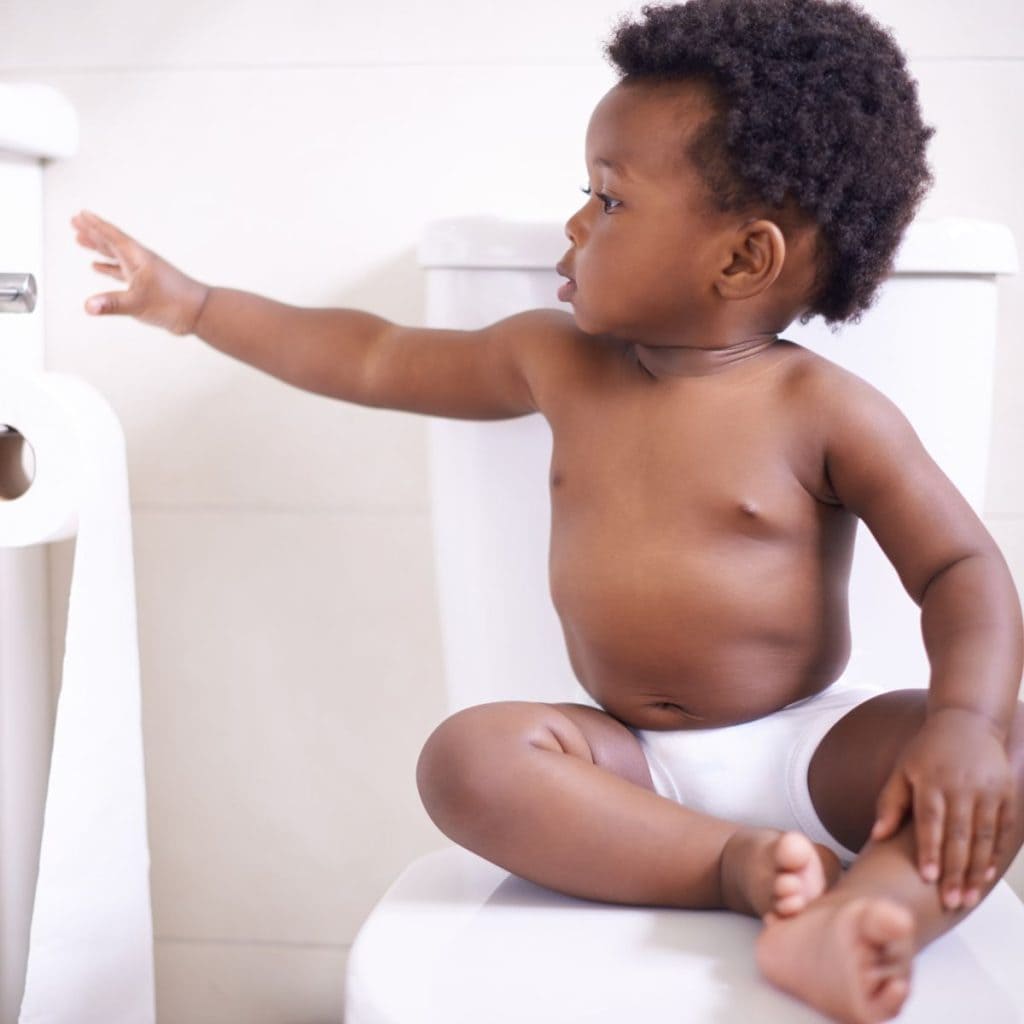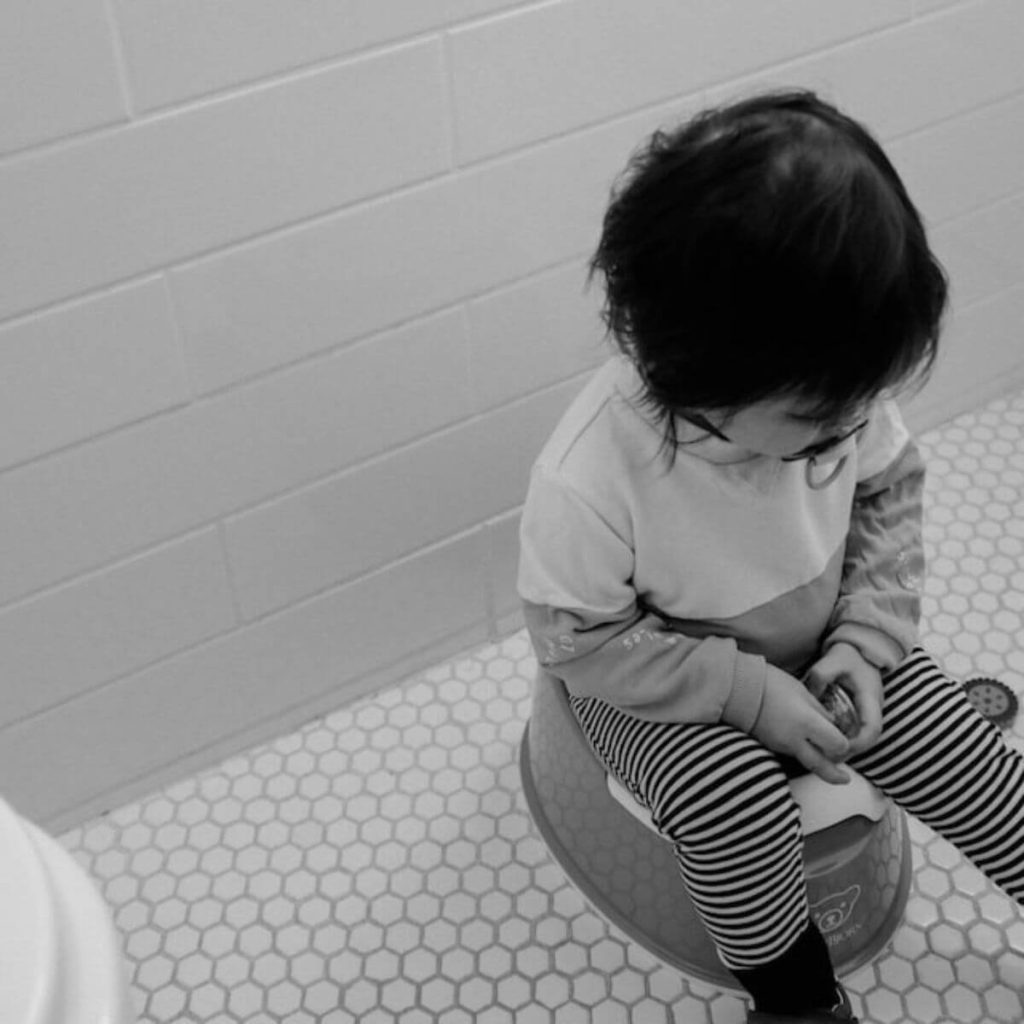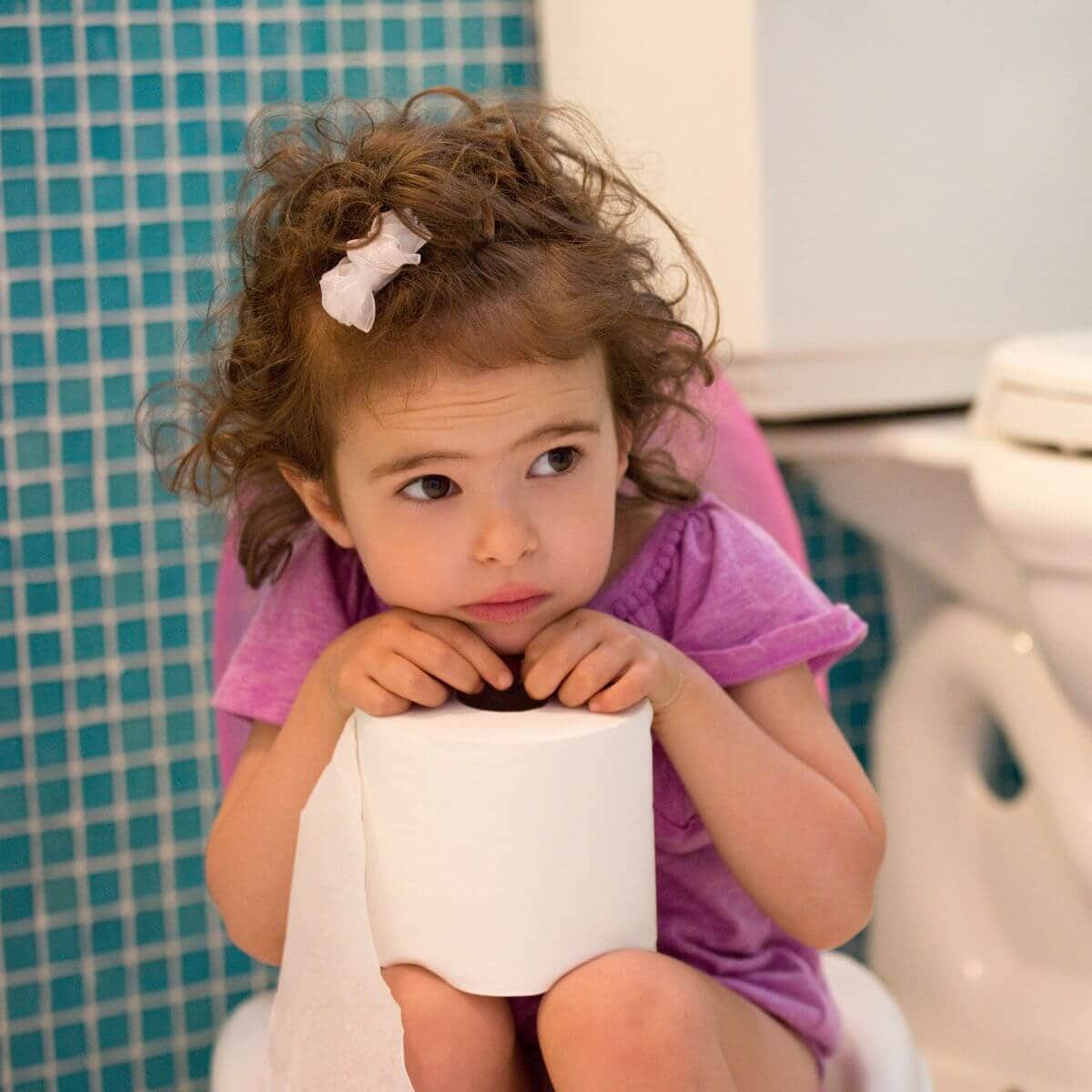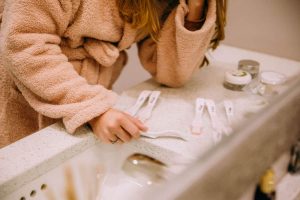If you’re looking for a gradual, child-led approach to potty training that fosters connection between you and your little one, look no further than Montessori potty training.
It’s a tried and true approach used successfully by caregivers in Montessori homes and Montessori classrooms around the world. Thousands of children learn to use the potty this way!
The Montessori potty training method blends easily into your child’s daily routine, encourages slow but sustainable progress, and helps parents kick diapers to the curb jaw-droppingly early. Let’s get into it!

This site contains affiliate links, meaning that we earn a small commission for purchases made through our site. We only recommend products we personally use, love, or have thoroughly vetted.
- Is Montessori Potty Training Right For My Child? (And Me?)
- What Are The Basic Principles Of Montessori Potty Training?
- What’s The Best Time To Start Montessori Potty Training?
- Preparing A Child For Montessori Potty Training From Birth
- Special Equipment To Purchase For Your Young Potty-Curious Toddler
- Getting Started With Montessori Potty Training
- Holding it All Together As A Parent During Montessori Potty Training
- Montessori Potty Training: A Special Note About Poop
- Montessori Potty Training: A Look Into the Future
- Additional Resources for Potty Training
Is Montessori Potty Training Right For My Child? (And Me?)
Parents who choose the Montessori potty training approach understand that true mastery of a skill takes place over months and years, not days.
It’s an approach that requires long-term commitment, but it also helps parents accept and settle into the ups and downs of potty training. We’re playing the long game, so one bad day (or bad week) of potty training problems is a-okay.
Montessori toddlers are typically using the potty months, if not years, earlier than their peers. My son, who potty trained at around 21 months, was eligible for more activities like summer camp thanks to his “potty trained” status.
I love this method of potty training, but I know it’s not right for every family. However you decide to potty train, always know you’re fully supported by the team at Undefining Motherhood! It’s tough, but you’ve got what it takes!
What Are The Basic Principles Of Montessori Potty Training?
The main principle of Montessori is “follow the child.” Always observe your child’s behaviors and wait for signs of readiness before starting Montessori potty training. (We’ll talk more about readiness in a minute.)
For that same reason, Montessori parents do not coax their children to the potty with either bribes (candy, ice cream, etc.) or punishments (shameful language). Instead, they rely on a child’s natural drive to learn.
Montessori caregivers believe it’s the work of a child to learn how to care for themselves, from combing their hair to using the potty. Teachers and parents use the phrases “toilet learning” and “potty learning” in place of potty training to emphasize the critical role of the child in their own education.
I’ll use multiple terms related to potty training interchangeably in this article, but now you know the Montessori jargon!
What’s The Best Time To Start Montessori Potty Training?
Montessori teachers recommend parents start what we think of as “potty training” at 18 to 24 months old. This is also known as the sensitive period for toileting or the period when your child is most eager to learn how to go potty.
This may seem early, but keep in mind, there is a significant amount of preparation that happens during infancy and early toddlerhood in Montessori households to get ready for the big P-O-T-T-Y. We’ll cover that next.
If you’re new to Montessori, or your child is a little older than the recommended age, you can one thousand percent still use the Montessori approach to toilet learning.
Some children become more resistant to potty training as they get older, but some truly need the extra time to mature. Again, it’s all about “following the child” and staying on their unique timeline.

Preparing A Child For Montessori Potty Training From Birth
As babies discover their hands and feet, they must also discover how their bodies remove waste. It’s our job as parents to provide a consistent environment and care routine that gives them all the information they need to be ready for actual potty training.
Quick side note: Some Montessori families use a technique called elimination communication in infancy. We won’t discuss it because it’s a little controversial, but it might be worth exploring!
How to Prepare For Montessori Potty Training With A Newborn Or Infant:
From day one, Montessori parents narrate their infant’s diaper changes, often doing them beside a mirror, on the floor, or near the bathroom. (We talk more about this in our article Montessori for Infants!)
With daily repetition, your child begins to pick up on the rhythms of their own self-care and the words used to describe it.
When a Montessori parent observes a baby that is clearly absorbed in a toy or exploring their environment, Montessori parents try to delay diaper changes if possible.
As you respect a child’s desires and hold space for them, they feel supported and more willingly move into self-care routines after playing.
Finally, parents are encouraged to use stand-up diaper changes when a baby can pull to stand. It’s exactly what it sounds like – you change a baby standing up! Here’s a short video to guide you.
(It’s totally fine to do the poopy ones laying down if you’re worried about mess.)
How To Prepare For Montessori Potty Training With A Young Toddler, 12-18 Months
With curious and mobile toddlers, don’t be shy about letting them in the bathroom while you’re peeing and pooping. Let’s be real. They’re going to be in there anyway.
You might not realize it, but they are constantly absorbing your words and actions. Let them watch you grabbing toilet paper, wiping your butt, and flushing. This is valuable information on pottying that they’ll draw from later.
Toddlerhood is also a great time to introduce a little potty to the bathroom. Invite your child to come sit on the potty (clothes on) and pretend to potty with you!
Special Equipment To Purchase For Your Young Potty-Curious Toddler
It’s important to have a comfortable and accessible potty before anything else. My sister and I both swear by the Baby Bjorn Smart Potty.
I appreciate that it’s low enough for a child to sit however they approach it.
At this age, we also introduced several potty books to our bookshelves. I highly recommend Going to the Potty by Fred Rogers and Potty by Leslie Patricelli.
When you’re ready, place your child in cotton underwear for a couple hours a day so they can actually feel the wetness when they urinate. (Yes, there will be pee on the floor!)
I purchased about three pairs of absorbent training pants for this time period, but I wouldn’t commit to buying a boatload of underwear until you’ve figured out what works for your child.
We ended up using girls’ panties. They felt less like diapers but offered some protection from surprise bowel movements. (Do avoid pull-ups as they are too similar to diapers.)
Getting Started With Montessori Potty Training
When a child exhibits signs of readiness, it’s time to kick things into higher gear in terms of potty training.
Readiness in a child looks like:
- strong interest in the potty and how it works,
- noticing when they have wet or soiled diapers,
- seeking privacy during a bowel movement,
- and having a dry diaper for longer periods of time including after a nap.
Toddlers don’t need to exhibit every sign of readiness to start, but it definitely helps to observe a couple.
Montessori Potty Training: A Hygge Home For the Potty
The bathroom can be a bit sterile-looking compared to the rest of the home, and since your child will be spending more and more time there, it’s time to get hygge (the Swedish concept of warm and cozy) with your potty space.
Make sure your toddler’s potty seat is in an accessible spot in the bathroom. Place a small basket of favorite books nearby as well as two containers–one full of fresh clothes and underwear, the other for dirty clothes.
We even used a small washable rug under our potty for coziness, but that’s definitely extra credit. You just want the potty to be inviting and comfortable.
You don’t have to be following Montessori to use this potty training hack! This comfy bathroom set-up worked equally well for my sister who followed a non-Montessori approach to potty training.
Montessori Potty Training: An Everyday Routine For Potty Learning
On day one of potty training, start by explaining the new daily routine to your child. You can say something like, “We’re going to be visiting the potty several times a day to practice going potty together. Today, we won’t be wearing any diapers.”
While some parents like to jump right into underwear, we found success by going commando for several weeks at the very beginning.
Invite your child to the potty around times you know they typically have bowel movements, as well as during transition periods. Transitions include first thing in the morning, before lunch, before leaving the house, before nap, etc.
You’ll probably encounter resistance to the new routine. It’s important to recognize their feelings are completely valid, but also to hold firm that they will be visiting the potty.
It’s tough to see your child experiencing negative emotions. Be supportive and loving in the same way you would if they needed their teeth brushed or a dose of vaccine at the doctor.
Montessori Potty Training: Practical Life Bathroom Edition
The actual potty visit can take around 10 minutes. Invite your child to undress if needed or provide assistance. Remind them, “You pee and poop in the potty,” but keep it matter-of-fact.
Ask them to sit on the potty and wait for them to settle. Perhaps read a short book together or help them locate the clean clothes and dirty clothes.
If they’ve had a “miss” or wet their undies, your child can place their soiled clothes in a designated dirty bin and also select fresh clothes if they need to dress again.
Invite your child to help you wipe up any urine on the floor and of course, visit the sink to practice handwashing with soap as well!
Holding it All Together As A Parent During Montessori Potty Training
According to the Pew Research Center, time spent with our children is both the most exhausting and yet the most meaningful compared to our work or school responsibilities. If that isn’t potty training in a nutshell!
Here are some tips to help YOU keep it together as you potty train:
1. Managing Stress and Anxiety
There’s no way to sugarcoat it. Pee is going to be all over the place. You are going to be struggling to manage your anxieties about the whole process. It’s tough.
Anticipate accidents and understand that progress is measured in weeks or months, not days. It’s totally fine to have moments where you don’t feel in control.
In fact, your child is in the driver’s seat for the first time, and maybe they are also feeling like they’re not completely qualified. This is a moment for you and your little one to accomplish something hard together. You’re a team.
Avoid shameful or accusatory language, but if you say something you don’t like, fess up to it. I’m constantly telling my son, “Mommy was feeling frustrated and said something she didn’t mean. I’m sorry. You’re doing great.”
Be supportive and get support for yourself if you need a break.
2. Managing The Bodily Fluids
Remove any rugs or pieces of furniture that you don’t want soaked in urine or feces, especially heirloom pieces.
Protect your furniture with flannel rubber sheeting and add waterproof covers to any mattress where your child rests or plays. We did not do this and lived to regret it!
Finally, you know your carpets will be taking a beating, so invest in some enzymatic spray like Nature’s Miracle that will actually degrade the urine and combat smells. Look for formulas designed for pet urine.

Montessori Potty Training: A Special Note About Poop
Regardless of the potty training method, taking a poo in the potty is a strange new experience for toddlers. It can make them uncomfortable.
It’s not a stretch to see that avoiding pooping can lead to constipation, making pooping downright painful.
Stay consistent with your potty routine and recognize that pooping is trickier than peeing for most children. It might take longer for kids to feel confident in their pooping skills.
If you do run into constipation issues, we’ve made a list of natural constipation in toddlers remedies.
Montessori Potty Training: A Look Into the Future
We’ve talked a lot about daytime potty training, but what about the night? It might surprise you to learn that daytime and nighttime potty training require different physiological milestones.
It’s a completely different set of skills and children may not be ready until they are much, much older. Like 5-7 years old!
Our founder Katy wrote all about nighttime potty training and how her research gave her confidence to let her son Jack nighttime potty train when he was good and ready! You go, girl!
Depending on where you’re at in your potty training journey, you may run into a dreaded potty training regression. You know you’re in a regression when out of the blue your potty-confident child starts having “misses” all over the house.
These turbulent periods are part of the learning process. We can help you get back on track with this article on potty training regression tips!
Montessori potty training is a slow but sustainable way to help your toddler ditch the diapers and learn to potty like a big kid. We love how the Montessori approach fosters connection between mothers and their babies during a very stressful time. If you give it a shot, we hope you love it too!
Are you already using Montessori potty training in your home? Or maybe you’re just starting to learn about the different ways to potty train? Let us know how you’re planning to potty train your little one!
Additional Resources for Potty Training
There is so much about Montessori potty training that it’s difficult to squeeze into one article. What about leaving the house? How do I teach my child to wipe their bum? What if my child is in a non-Montessori school?
There are entire courses on Montessori Potty Training! I know you’ve still got questions or are looking to dive even deeper, so I’ve put together a list of additional resources:
- The Montessori Baby and The Montessori Toddler
- The Montessori Notebook 2-Hour Online Course
- Montessori At Home: Potty Training Video (Free!)
- Shelf Help Podcast: An Introduction to Potty Learning (Free!)
- Monti Kids Toilet Learning Kit
- Diaper Free Baby Network
- The Secret of Childhood by Maria Montessori (Extra Credit)











